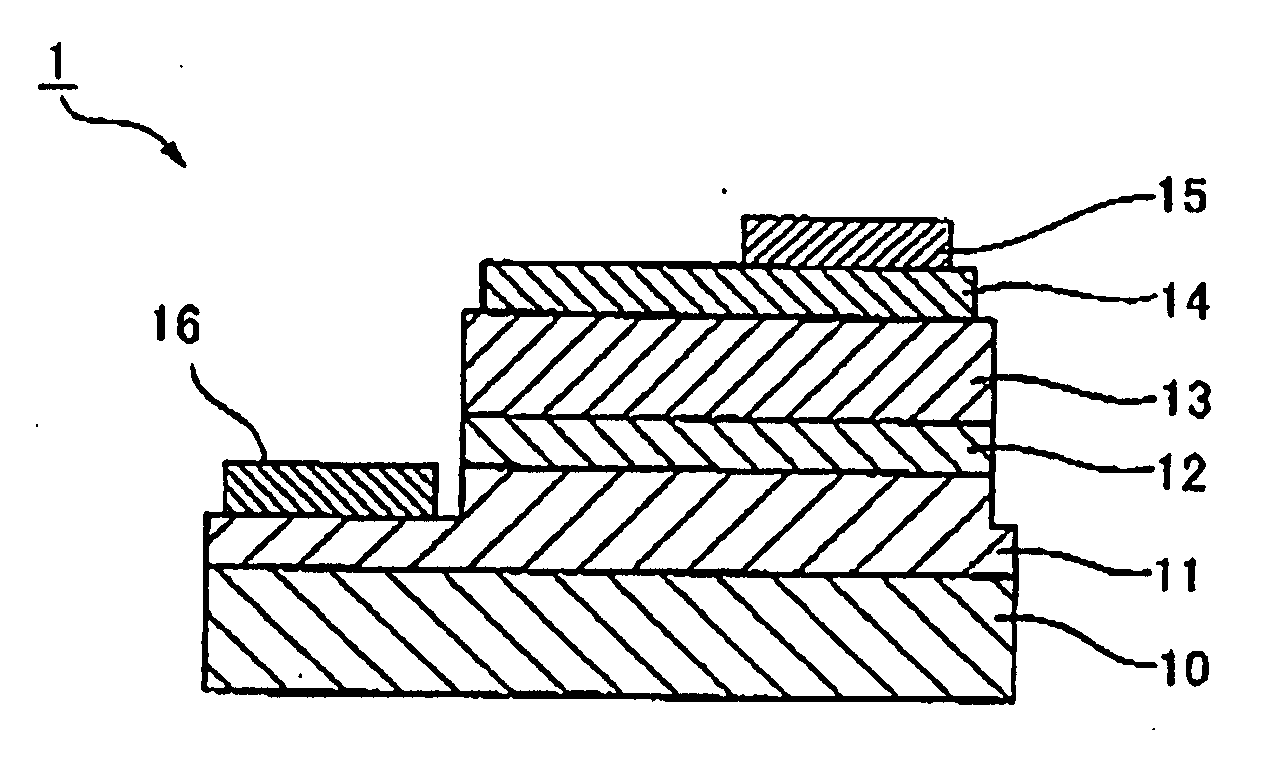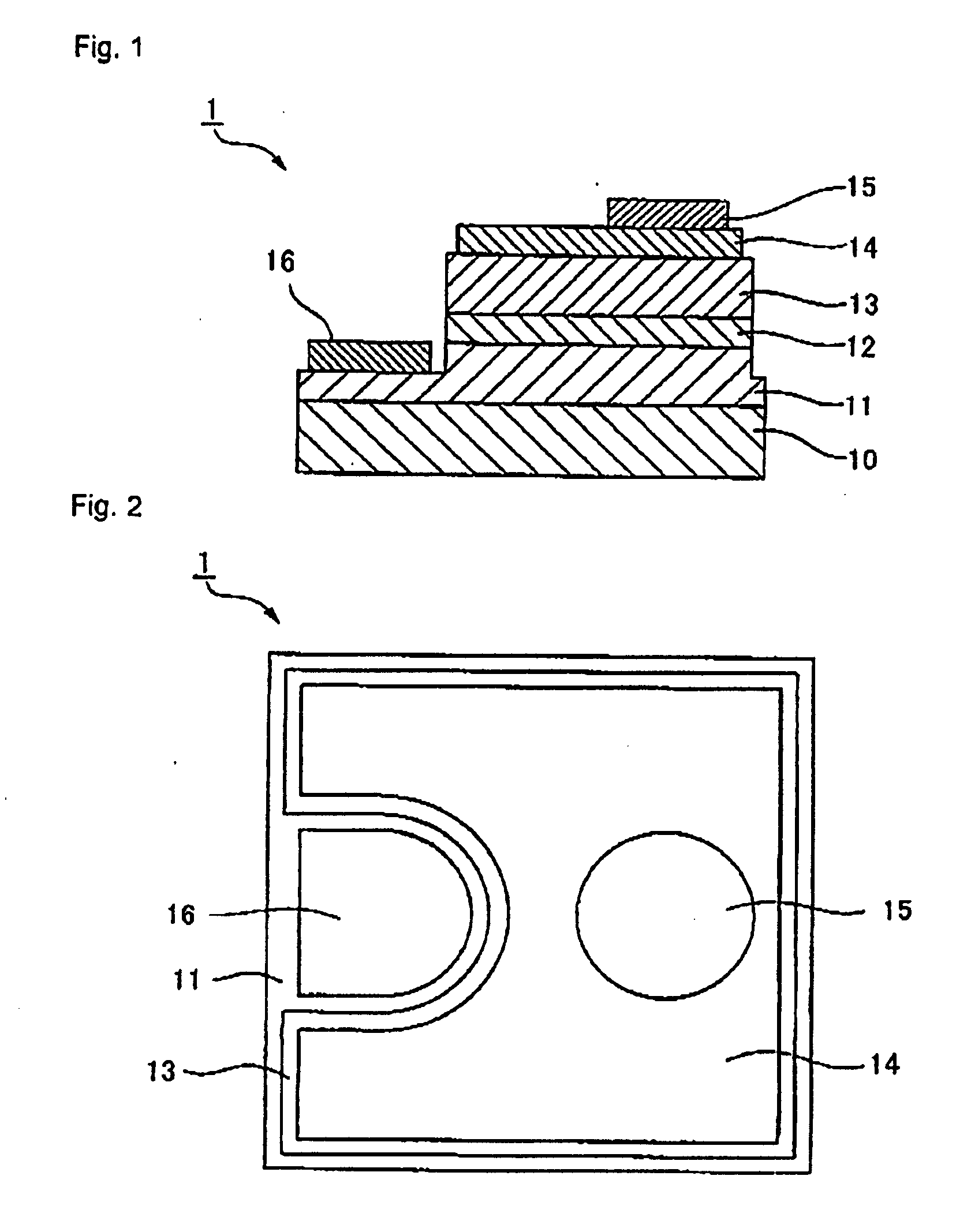Semiconductor light-emitting element, method for manufacturing the semiconductor light-emitting element and lamp that uses the semiconductor light-emitting element
a technology of semiconductor light-emitting elements and semiconductor light-emitting elements, which is applied in the direction of semiconductor/solid-state device manufacturing, semiconductor devices, electrical devices, etc., can solve the problems of difficult to fine film, reduce the adhesion of film to the underneath substrate, and block the light-emitting layer by the electrode, etc., to achieve excellent light-emitting properties, improve light permeability, and improve the effect of light permeability
- Summary
- Abstract
- Description
- Claims
- Application Information
AI Technical Summary
Benefits of technology
Problems solved by technology
Method used
Image
Examples
example 1
Manufacturing a Gallium Nitride Semiconductor Layer
[0127]A gallium nitride semiconductor layer was manufactured as described below.
[0128]That is, an undoped GaN under layer (layer thickness 2000 nm), Si doped n-type GaN contact layer (layer thickness 2000 nm, carrier density=1×1019 cm−3), Si doped n-type Al0.07Ga0.93N clad layer (layer thickness 12.5 nm, carrier density=1×1018 cm−3), a multiple quantum structure comprising six Si doped GAN barrier layers (layer thickness 14.0 nm, carrier density=1×1018 cm−3) and five undoped In0.20Ga0.80N well layers (layer thickness 2.5 nm), Mg doped p-type Al0.07Ga0.93N clad layer (layer thickness 10 nm), and Mg doped p-type GaN contact layer (layer thickness 100 nm) were sequentially layered on a sapphire c-plane ((0001) crystal plane) substrate via an AlN buffer layer. Each of the layers of the layered structure of the gallium nitride semiconductor layer described was grown by reduced pressure MOCVD.
(Manufacturing the Semiconductor Light-Emittin...
example 2
[0139]The same semiconductor light-emitting element as in example 1 was manufactured except that the transparent conductive film that is formed on the p-type GaN contact layer of the gallium nitride semiconductor layer was changed to a transparent conductive film comprising an oxide of indium, gallium and tin, the annealing temperature after patterning of the transparent conductive film was 400° C., and after creating a vacuum of 1 Pa or less inside the furnace before the annealing process, highly pure nitrogen gas having a purity of 4N was introduced into the furnace.
[0140]Here, in the sputtering of the transparent conductive film, an oxide sintered compact target was used in which gallium was contained at an amount of a Ga / (In+Ga+Sn) atomic ratio of 0.15, and tin was contained at an amount of a Sn / (In+Ga+Sn) atomic ratio of 0.05.
[0141]The transparent conductive film (hereafter referred to as “GITO15”) comprising an oxide of indium, gallium and tin and formed by the method describe...
example 3
[0144]The same semiconductor light-emitting element as in example 1 was manufactured except that the transparent conductive film that is formed on the p-type GaN contact layer of the gallium nitride semiconductor layer was changed to a transparent conductive film comprising an oxide of indium, gallium and tin, the atmosphere of the annealing process after patterning of the semiconductor conductive film was a vacuum, and the annealing temperature was 400° C.
[0145]Here, in the sputtering of the transparent conductive film, an oxide sintered compact target was used in which gallium was contained at an amount of a Ga / (In+Ga+Sn) atomic ratio of 0.05, and tin was contained at an amount of a Sn / (In+Ga+Sn) atomic ratio of 0.09.
[0146]The transparent conductive film (hereafter referred to as “GITO5”) comprising an oxide of indium, gallium and tin and formed by the method described above, had relatively high transmittance of 85% or greater in the wavelength range of 450 nm and 75% or greater i...
PUM
 Login to View More
Login to View More Abstract
Description
Claims
Application Information
 Login to View More
Login to View More - R&D
- Intellectual Property
- Life Sciences
- Materials
- Tech Scout
- Unparalleled Data Quality
- Higher Quality Content
- 60% Fewer Hallucinations
Browse by: Latest US Patents, China's latest patents, Technical Efficacy Thesaurus, Application Domain, Technology Topic, Popular Technical Reports.
© 2025 PatSnap. All rights reserved.Legal|Privacy policy|Modern Slavery Act Transparency Statement|Sitemap|About US| Contact US: help@patsnap.com



